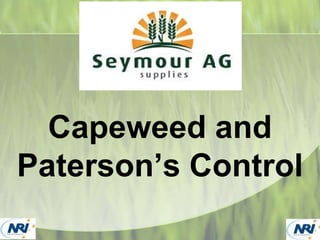Capeweed and PatersonŌĆÖs Curse Control
- 2. A little bit about Seymour Ag: ŌĆó Website ŌĆō SeymourAg.com.au ŌĆó New company Seymour Ag Supplies ŌĆó Been going for 7 months ŌĆó Belong to NRI ŌĆó Staff consists of ŌĆō Kate ŌĆō Jeanette ŌĆō Myself Aim to provide great products With good service and good advice
- 3. Capeweed & PatersonŌĆÖs Curse
- 4. Capeweed & PatersonŌĆÖs Curse
- 5. Capeweed & PatersonŌĆÖs Curse
- 6. Capeweed & PatersonŌĆÖs Curse
- 7. Controlling PatersonŌĆÖs Curse & Capeweed Latest stages to control these weeds Why??
- 8. Capeweed ŌĆó Likes false breaks ŌĆō soil temp. 15 deg ŌĆó Early rains with 3-5 weeks dry best ŌĆó Rarely germinates after a late break ŌĆó Seed remains in soil for years ŌĆó On surface lasts for 2 years ŌĆó Wrapped in wool improves germination
- 9. Toxicity of Capeweed ŌĆó accumulate nitrate levels high enough (2-4.7% dry matter) to cause toxicity to stock especially after spraying with hormone herbicides like 2,4-D ŌĆó Early season spraying in warmer temperatures and in dull weather is associated with increased risk of toxicity ŌĆó Avoid grazing with horses, pigs and young or breeding stock. Animals that have suffered previous nutritional stress appear to be more susceptible to poisoning
- 10. Symptoms of Poisioning ŌĆó Depression, loss of appetite, pale mucous membranes, salivation, gasping, muscle tremors, staggering, collapse, coma and death. ŌĆó Cattle may suffer rapid death within an hour of exposure
- 11. PatersonŌĆÖs Curse ŌĆó Germinates on false break ŌĆó Not a good competitor ŌĆó Can germinate with a summer rain ŌĆó Seeds at up to 30,000 seeds per sq metre ŌĆó Extremely toxic to horses ŌĆó contains compounds known as pyrolizidine alkaloids ŌĆó the metabolites of which cause cell death in organs throughout the body
- 12. PatersonŌĆÖs Curse ŌĆó Liver damage is cumulative ŌĆó Grazing on it in years when there is little ŌĆó Then suffering when it is a big year ŌĆó Non-preferred grazing -- first green pick
- 13. PatersonŌĆÖs Curse ŌĆó Contains damaging alkaloids ŌĆó Damages sheep livers ŌĆó Copper toxicity ----------- care ŌĆó Cumulative ŌĆó Plants have higher alkaloid levels at flowering
- 14. ALLELOPATHY ’ü▒ Refers to the chemical inhibition of one species by another ’ü▒ These chemicals can inhibit root & shoot growth & nutrient uptake ’ü▒ Prevent other plants from using resources
- 15. Examples of Allelopathic Plants ŌĆó Examples are some gums (sugar gum), wattles, Casuarinas, ŌĆó Lucerne, clover, vetch and Patersons curse and capeweed?
- 16. What does this mean? ŌĆó These weeds will out compete pasture ŌĆó Leave bare ground in summer ŌĆó More potential for these two weeds ŌĆó PatersonŌĆÖs Curse can produce 30,000 seeds per square metre
- 17. Control Methods ŌĆó Control when the weeds are small ŌĆó Have some competition for bare space ŌĆó Plant competitive species ŌĆō clover, ryegrass
- 18. Control Methods Spray-Graze ŌĆó sub-lethal doses of chemicals ŌĆó ŌĆ£sweetensŌĆØ up weeds making it attractive to stock ŌĆó Must graze heavily after 7 days ŌĆó Need good mix of other species ŌĆó Take stock off enabling pasture to recover
- 19. Chemical Control Broadstrike /Multitude ŌĆó 25g per ha ŌĆō low rate ŌĆó Very ŌĆ£softŌĆØ, clover, lucerne, grass safe ŌĆó Add wetter ŌĆó Works best on sunny days ŌĆó Good on wild radish, mustards, ŌĆó Add wetter, oil ŌĆó Add Igran /Salvation for increased control
- 20. Chemical Control Trigrex ŌĆō Nugrex ŌĆō various ŌĆó Combination mixed product ŌĆó Great on smaller weeds ŌĆó Safe on clovers etc ŌĆó Graze after will improve control ŌĆó Stick to the above brands ŌĆō different solvents ŌĆó Wetter
- 21. Chemical Control Agtryne ŌĆó Combined trybryne and MCPA ŌĆó Single rate ŌĆō single product ŌĆó Great for heavy infestations ŌĆó Some clovers are effected ŌĆó Rates ŌĆō ŌĆó DonŌĆÖt add wetter!!! There is enough in it
- 22. Chemical Control Igran/Salvation + MCPA ŌĆó Mix the rate to suit the weed size ŌĆó Start with 300+300 ŌĆō move up to 500+500 as weeds get bigger ŌĆó Can be used alone if needed but MCPA seems ŌĆó To soften Salvation ŌĆó No Wetter ŌĆó Prefer Salvation as it has a new cold stable formulation!!
- 23. Chemical Control Metsulfuron ŌĆō Brushoff, Ally, various ŌĆó Low rates --- Add wetter Care needs to be taken cleaning sprayer ŌĆó Will kill clover ŌĆō cannot plant pasture as there is a residual
- 24. Chemical Control ŌĆó And of course Amine 625 ŌĆó Only spray between April and August ŌĆó Must graze or weeds will recover ŌĆó 500 mls/ha ŌĆó Many brands
- 25. Summary 1. Identify the weeds 2. SPRAY EARLY ŌĆō let the pasture take over 3. Have good pasture species to dominate 4. DonŌĆÖt graze good pasture to leave bare ground 5. Plant alternative vegetation SPRAY EARLY
- 26. MOST IMPORTANT SPRAY EARLY -Plan Now!! See us at Seymour Ag Supplies 36 High Street Seymour Site 106 - 107 03 5792 1855 Rob-- 0408 882 698
- 27. Full Presentation Get the full presentation on Our website ŌĆō www.SeymourAg.com.au Or leave your name and email On the pad or take a card




























